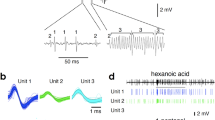Summary
-
1.
Chemoreceptor units were investigated electrophysiologically in the apical sensory cone on the antenna of the desert isopod,Hemilepistus reaumuri. Activity of 141 single units was recorded from fibres in the antennal nerve.
-
2.
The receptors responded to a variety of chemical substances with excitation up to 300 imp/s or with inhibition. They were classified into distinct physiological response types with non-overlapping response spectra (Table 1).
-
3.
Two physiological response types were excited by airborne odour stimuli: (a) butyric acid cells were sensitive to short-chain fatty acids and aldehydes (Table 3); (b) amine cells responded to short-chain mono- and diamines (Table 5).
-
4.
Four groups of gustatory cells were found: (c) sugar cells responded to several sugars and α-glucosides (Table 6); (d) calcium cells were excited by CaCl2 which was inhibitory in most other cells; (e) amino acid cells were found in only two cases, responding to 1-asparagine and 1-methionine; (f) 29 cells responded only to an aqueous rinse of desert woodlice, and not to other stimuli tested.
-
5.
Olfactory cells responded to n-fatty acids (namines, respectively) with phasic-tonic excitation at low concentrations, but with phasic excitation followed by an off-response at higher concentrations (Figs. 1, 3). Complete inhibition could be caused by applying still higher concentrations of the same substances.
-
6.
Transition from phasic-tonic to phasic responses occurred at low initial impulse frequencies with some stimulus substances, but at high initial frequencies with other substances in the same receptor cell (Figs. 1, 3). Chain length of the stimulus molecule influenced phasic-tonic behaviour in a different manner in both olfactory cell groups (Tables 2, 4).
-
7.
No influence of stimulus concentration on time course was found in sugar cells (Figs. 4a, b, 5). There were, however, remarkable differences in the poststimulatory frequency decay for different sugars (Fig. 4a, b).
Similar content being viewed by others
References
Abraham A, Wolsky A (1929) Über die Nerven und Nervenendigungen der Antennen einiger Landisopoden. Zool Anz 84:316–323
Alexander CG (1977) Antennal sense organs in the isopodLigia oceanica. Mar Behav Physiol 5:61–77
Atema J (1977) Functional separation of smell and taste in fish and crustacea. In:LeMagnen J, MacLeod P (eds) Olfaction and taste, vol VI. IRL Press, London Washington, DC, pp 165–174
Behrend K (1971) Riechen in Wasser und Luft beiDytiscus marginalis L. Z Vergl Physiol 75:108–122
Bauer U, Hatt H (1980) Demonstration of three different types of chemosensitive units in the crayfish claw using a computerized evaluation. Neurosci Lett 17:209–214
Bauer U, Dudel J, Hatt H (1981) Characteristics of single chemoreceptive units sensitive to amino acids and related substances in the crayfish leg. J Comp Physiol 144:67–74
Derby CD, Atema J (1982a) Narrow-spectrum chemoreceptor cells in the walking legs of the lobsterHomarus americanus: taste specialists. J Comp Physiol 146:181–189
Derby CD, Atema J (1982b) Chemosensitivity of walking legs of the lobsterHomarus americanus: neurophysiological response spectrum and thresholds. J Exp Biol 98:303–315
Fischbach E (1954) Licht-, Schwere- und Geruchssinn bei Isopoden. Zool Jahrb Abt Allg Zool Physiol 65:141–170
Fuzessery ZM (1978) Quantitative stimulation of antennular chemoreceptors of the spiny lobster,Panulirus argus. Comp Biochem Physiol 60:303–308
Fuzessery ZM, Carr WES, Ache BW (1978) Antennular chemosensitivity in the spiny lobster,Panulirus argus: Studies of taurine sensitive receptors. Biol Bull 154:226–240
Gupta M (1962) Contact chemoreception inOniscus asellus andPorcellio scaber. J Zool Soc Ind 14:145–149
Henke G (1960) Sinnesphysiologische Untersuchungen bei Landisopoden, insbesondere beiPorcellio scaber. Verh Dtsch Zool Ges 54:167–171
Kafka WA (1970) Molekulare Wechselwirkungen bei der Erregung einzelner Riechzellen. Z Vergl Physiol 70:105–143
Kaissling KE (1977) Control of insect behaviour via chemoreceptor organs. In:Shorey HH, McKelvey JJ jr (eds) Chemical control of insect behaviour: theory and applications. Wiley, London New York, pp 45–65
Linsenmair KE (1972) Die Bedeutung familienspezifischer “Abzeichen” für den Familienzusammenhalt bei der sozialen WüstenasselHemilepistus reaumuri. Z Tierpsychol 31:131–162
Linsenmair KE, Linsenmair Ch (1971) Paarbildung und Paarzusammenhalt bei der monogamen WüstenasselHemilepistus reaumuri. Z Tierpsychol 29:134–155
Mead F (1970) Observations sur le comportement sexuel de l'Isopode terrestreMetoponorthus sexfasciatus Budde-Lund. Bull Soc Zool France 95:55–60
Mead F, Gabouriaut D, Corbière-Tichané G (1976) Structure de l'organe sensoriel apical de l'antenne chez l'Isopode terrestreMetoponorthus sexfasciatus. Zoomorphologie 83:253–269
Price RB, Ache BW (1977) Peripheral modification of chemosensory information in the spiny lobster. Comp Biochem Physiol [A] 57:249–253
Rüth E (1976) Elektrophysiologie der Sensilla chaetica auf den Antennen vonPeriplaneta americana. J Comp Physiol 105:55–64
Schaller A (1926) Sinnesphysiologische und psychologische Untersuchungen an Wasserkäfern und Fischen. Z Vergl Physiol 4:370–464
Schmitt BC, Ache BW (1979) Olfaction: Responses of a decapod crustacean are enhanced by flicking. Science 205:204–206
Schneider P (1971) Lebensweise und soziales Verhalten der WüstenasselHemilepistus afghanicus. Z Tierpsychol 29:121–133
Schneider P (1973) Über die Geruchsrezeptoren der afghanischen Wüstenassel. Naturwissenschaften 60:106–107
Seelinger G (1977) Der Antennenendzapfen der tunesischen WüstenasselHemilepistus reaumuri, ein komplexes Sinnesorgan. J Comp Physiol 113:95–103
Shepheard P (1974) Chemoreception in the antennule of the lobster,Homarus americanus. Mar Behav Physiol 2:261–273
Städler E, Hanson FE (1975) Olfactory capabilities of the ‘gustatory’ chemoreceptors of the Tobacco Hornworm larvae. J Comp Physiol 104:97–102
Author information
Authors and Affiliations
Rights and permissions
About this article
Cite this article
Seelinger, G. Response characteristics and specificity of chemoreceptors inHemilepistus reaumuri (Crustacea, Isopoda). J. Comp. Physiol. 152, 219–229 (1983). https://doi.org/10.1007/BF00611186
Accepted:
Issue Date:
DOI: https://doi.org/10.1007/BF00611186




